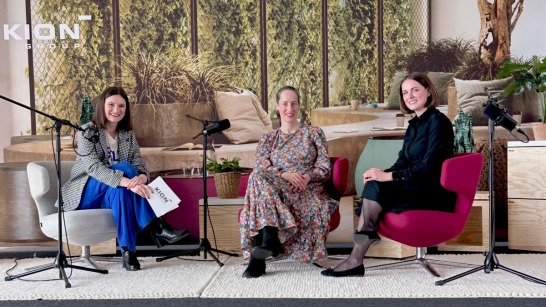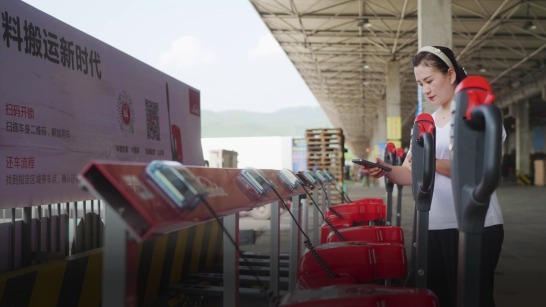2023-06-07
Ensuring Progress through Innovation and Technology
As global leaders in technology, the KION Group and its subsidiaries understand the value of thinking big. In line with this, they adopt a comprehensive patent strategy which not only aims to protect intellectual property, open up new markets and increase competitiveness, but also to create an ideal framework in which innovation can thrive and to promote ingenuity at the company. After all, finding the best ideas now can have a decisive impact on the future.

The origins of Dematic go back more than 200 years. This KION subsidiary—then named Demag AG—first filed patents over 100 years ago. At the time, Demag was the result of a merger of three mechanical engineering companies that had previously been competitors. The oldest of the companies—Mechanische Werkstätte Harkort & Co—was founded in 1819 in Wetter an der Ruhr. The company developed steam engines, whilst crane construction and conveyor technology originated with the Stuckenholz family, which was also part of the merger. Even at this time, it was clear just how important patents were to future-oriented corporate management.
Therefore, technical innovations were patented at an early stage in order to optimize work processes and to secure the rights to the company's own innovative ideas. Although technical developments have advanced enormously since then, the motivations behind the ideas remain the same—to optimize processes, reduce workload and discover and devise new solutions. Accordingly, the number of patents filed remains consistent at around 100 per year.
The Idea is the Essence of any Patent
Patents are industrial property rights for inventions to prevent them from being recreated without permission. As such, they are an indispensable tool for corporate strategy at Dematic and all the other KION Group brands. A patent formally consists of several components. One of these is the bibliographic section that includes the patent number, information regarding the inventor, the holder and date on which it was filed. This section is then supplemented by both the detailed description and the claims section covering the legal rights that the individual or company filing the patent wishes to secure. In addition, a patent always includes drawings to provide a graphic representation of the invention. However, the essence of any patent is the original inventive idea above all else.

As global leaders in technology, the KION Group and its subsidiaries understand the value of thinking big. In line with this, they adopt a comprehensive patent strategy which not only aims to protect intellectual property.
Requirements for a Patent Application
To enable such inventive ideas to be transformed into future assets, the KION Group has established a suitable framework by means of internal patent strategy processes in order to identify inventions that are worth protecting and to promote their further development. “As a first step, the Patent Department receives notifications of all inventions from across the group. A patent committee then decides whether these inventions meet all the requirements for a patent application,” explains Dr. Joachim Tödter, Senior Director Technology & Innovation and member of the Patent Council for the KION brands STILL, Linde Material Handling and Dematic. At STILL, Dr. Tödter managed the Patent Division for several years by himself. He knows that, although the list of requirements is long, it essentially allows the committee to decipher the commercial applicability and practical value of an innovation for KION. “For example, there’s a reason why no one is able to patent a perpetual motion machine. On a technical level, it’s impossible to implement because it violates the laws of physics,” he adds.
A further requirement is the novelty check which ensures that there have been no previous technical or academic publications regarding the respective technology. After that comes the “inventive step” which checks whether the application is sufficiently inventive. If all requirements are met and depending on the decision made by the Patent Committee, the invention then passes to the final stage. “At this stage the patent attorney drafts a patent application, working closely with the inventor or the responsible team to implement patent protection that is as extensive and detailed as possible,” states Joachim Tödter. After a final check, the application is officially filed with the local office and what started as an initial idea becomes a market-relevant patent. But where to these ideas come from in the first place?
Customer Relations as a Source of Inspiration
To answer this question, we need to take a holistic view of the group. As a leader in technology, KION encourages the early and timely submission of invention notifications from all possible sources. Project Managers in the Research and Development Department (including not only the CTO but also Product and Project Managers as well as Global Business Solutions members) are required to identify any potential inventions during the development stage and to report these to the patent department.
The creation of patents is, therefore, not something that is limited to development and innovation departments. It is often the case that visionary ideas originate from sales departments. “Ideas for patents—known as business solutions—often arise from working closely with customers. These ideas are based on a needs analysis that is then formalized by the inventors and subsequently assessed internally,” describes Volker Gaber, Patent Manager at Dematic. Afterwards, the new technology is tested in concrete application cases and test scenarios. If this testing reveals a need for improvement, the technology will be further developed and refined. “The invention starts to take shape, so to speak, and is supplemented by additional detail and improvement patents, if necessary,” explains the patent expert at Dematic.
Improving Competitiveness through Patents
For companies, every secured patent is an effective means of gaining an advantage within a highly competitive market. In light of this, the patent strategy at the KION Group also adopts an offensive approach by aiming to secure market share and challenge competitors. “We want to target ‘white spots’ and are working at full capacity to identify and occupy these as far as possible,” explains Joachim Tödter. “White spots” are critical company and brand positions that are currently unoccupied but hold a great deal of potential for innovation.
Patents serve as a kind of entry ticket for these markets. Cross-licensing agreements, which authorize companies to use other companies’ patents, also come into play here. “Blocking patents,” which prevent third parties from entering a specific market segment, are even more important. This creates room for maneuver. ultimately allowing a company to position itself as a leader in a segment. However, Tödter understands that this process is more complicated than it first seems, “The competition never sleeps. Appeals and lawsuits against blocking patents are a proven method of preventing companies from occupying white spots.” The solution involved creating “patent clusters” to preempt attempts to bypass blocking patents and cover future developments ahead of time. “The world of patents is far from boring. It’s an extremely dynamic environment that is full of conflict,” states Volker Gaber.

Since the 1980s, Dematic has secured important patents for linear and circular sorters.
A Question of Recognition
Wherever there is conflict, there are winners and the list of wins and secured patents for the KION subsidiary Dematic is a long one. Since the 1980s, the company has secured important patents for linear and circular sorters. However, Dematic has strategic patents in other areas too. According to Volker Gaber, “In the area of accumulation—encompassing the stowage, collection and onward transport of conveyed goods—Dematic holds a significant number of patents.”
It is not only the number of patents the company has that makes the difference because not every patent has the same value. Some patents come with a certain prestige that should not be underestimated as these are what reinforce the company’s core competencies. Volker Gaber mentions the Multishuttle system as an example of a prestigious patent at Dematic. “We are market leaders in this unique area,” he explains. To ensure this remains the case in the future, the KION Group patent strategy protects the technology behind the Multishuttle systems from being copied.
Finally, there is one last and somewhat different aspect of the patent strategy—appreciation of employees. “Patents also always entail a level of appreciation for the colleagues who were involved,” explains Gaber. “When an invention is registered, the employees who worked on the innovation enjoy a certain reputation. And rightly so. They should be really proud of what they achieved.” Showing appreciation for employees is crucial as the ingenuity, innovative spirit and inventiveness of the workforce are the reason that the KION Group is able to maintain its position as a worldwide technology leader in intralogistics.

